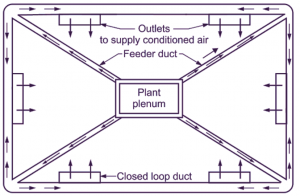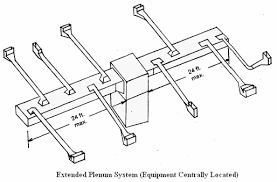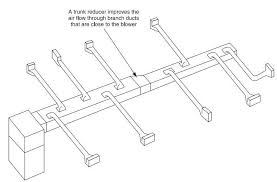5 System Designs
Duct design depends on the primary purpose of the system, heating or cooling. How and where the duct is installed also determines the configuration of the air handler. Each configuration will be best suited with a type of duct system.
Radial Duct-A radial system when used for heating is best suited for a rancher style home with the ductwork placed in the concrete slab. The air handler, a downflow with a central plenum, is located on the floor level with individual branch lines run to each room in the slab. The radial design is also used for cooling systems when installed in an attic space. A horizontal unit will be used with a similar ductwork design being distributed through the ceiling.
Radial/Perimeter Loop– Similar to the radial and used in the same situations, the radial loop has the addition of a duct which runs the entire perimeter of the building, joining all the individual branch lines. Because the branches lines are connected, the perimeter loop system can be balanced more effectively than the radial system.
Similar to the radial and used in the same situations, the radial loop has the addition of a duct which runs the entire perimeter of the building, joining all the individual branch lines. Because the branches lines are connected, the perimeter loop system can be balanced more effectively than the radial system.
Extended Plenum  is a more traditional duct design for heating. It consists of supply and return plenums, trunk lines and branch lines. It suits a 2 story home well with an upflow or lowboy air handler on the 1st floor or basement and the duct in the ceiling of that floor. With the duct in the floor level of the main living space, the warm conditioned air will rise and create the natural circulation required. A slightly modified version of this design is the Graduated Extending Plenum also called a
is a more traditional duct design for heating. It consists of supply and return plenums, trunk lines and branch lines. It suits a 2 story home well with an upflow or lowboy air handler on the 1st floor or basement and the duct in the ceiling of that floor. With the duct in the floor level of the main living space, the warm conditioned air will rise and create the natural circulation required. A slightly modified version of this design is the Graduated Extending Plenum also called a  Reducing Extending Plenum. In this design, the supply plenum reduces proportionally when the amount of air or CFM (cubic feet per minute) reduces. This keeps the velocity or FPM (feet per minute) at a consistent speed, which allows the trunk to span a much longer distance while preserving desired air quantities.
Reducing Extending Plenum. In this design, the supply plenum reduces proportionally when the amount of air or CFM (cubic feet per minute) reduces. This keeps the velocity or FPM (feet per minute) at a consistent speed, which allows the trunk to span a much longer distance while preserving desired air quantities.
